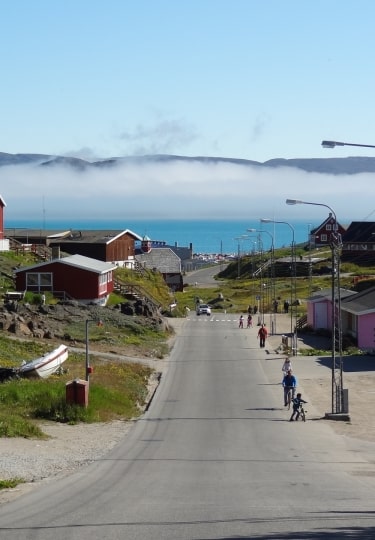Head to the Arctic to experience pristine, untouched outdoors, wildlife, and authentic culture. Greenland is a nature-lover’s paradise, with sweeping landscapes to explore, rich history, and heritage to uncover.
Situated in the midst of a scenic fjord system in the southern region of the country, the village of Qaqortoq spills over a hillside that curves around a sheltered bay. You’re never far from nature here, with hiking, kayaking, and fishing close at hand to satisfy any outdoor enthusiast’s interests.
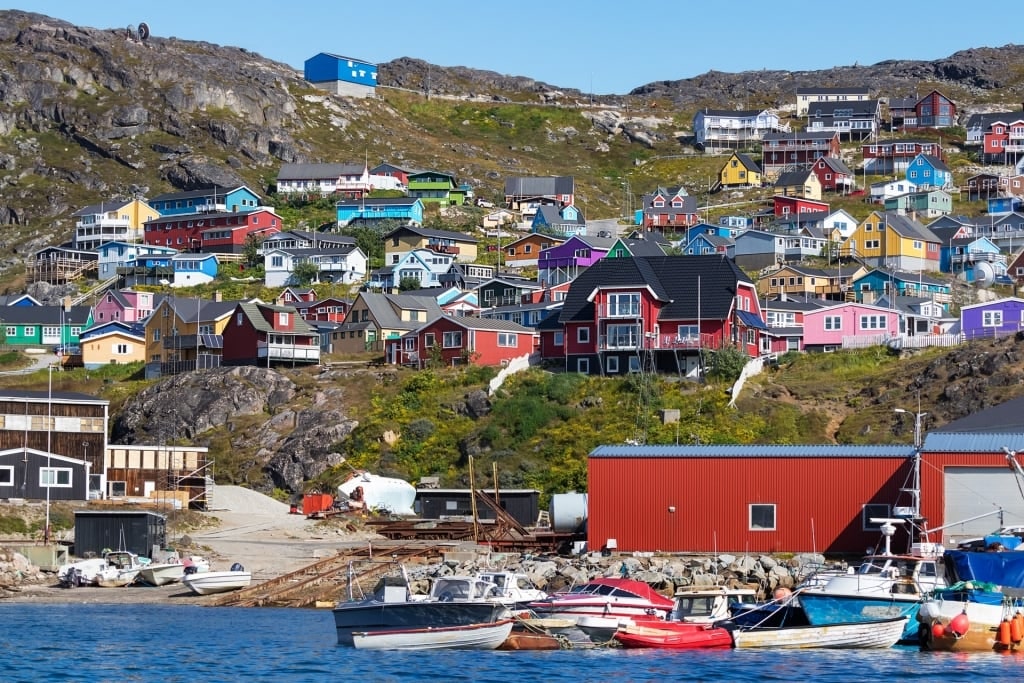
Qaqortoq
Whether you’re interested in sampling local cuisine, viewing ancient Viking ruins, or paddling a kayak around icebergs, there’s an adventure for land, sea, and sky that appeals to every type of traveler. Discover the magic of Qaqortoq with this insider’s guide to one of Greenland’s most beautiful and cultural treasures.
Why Visit Qaqortoq?
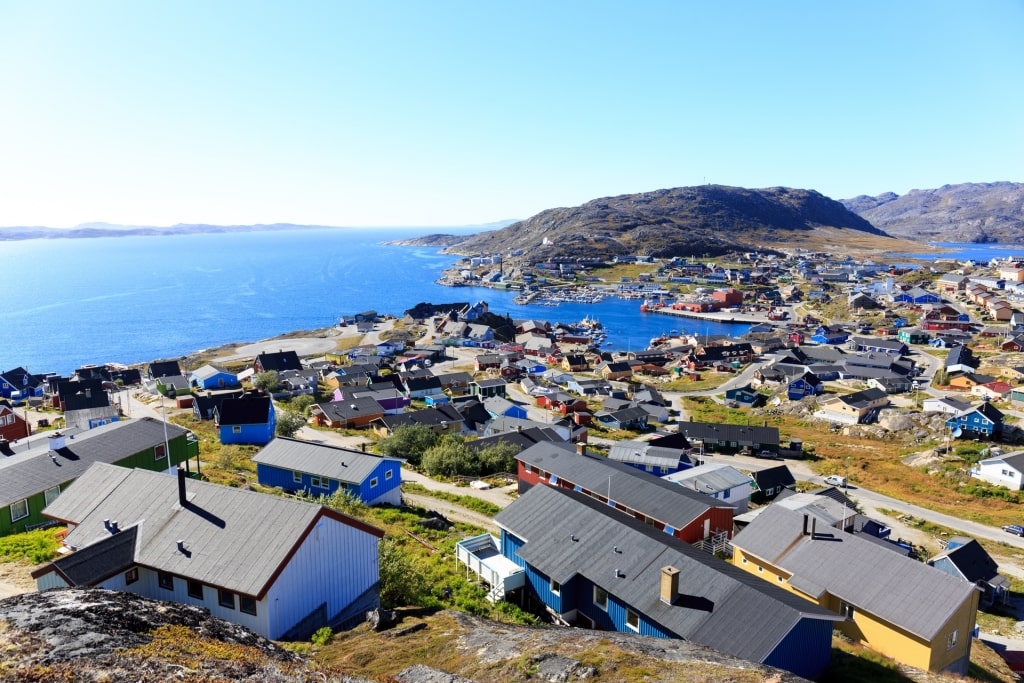
Qaqortoq
The walkable village of Qaqortoq, with a population of just 3,000, is like an open-air museum, with colorful, Nordic-inspired architecture, ancient churches, museums, Nordic artwork, and other historical points of interest. It’s also home to the only fountain in Greenland, located in the village square, with Qaqortoq residents’ names engraved on it.
But you’re here as much for the connection to nature as for the historic town; within easy reach you’ll find hiking, kayaking, the flower-strewn tundra, and the unexpected contrasts of both hot springs and giant icebergs.
Qaqortoq’s History & Culture
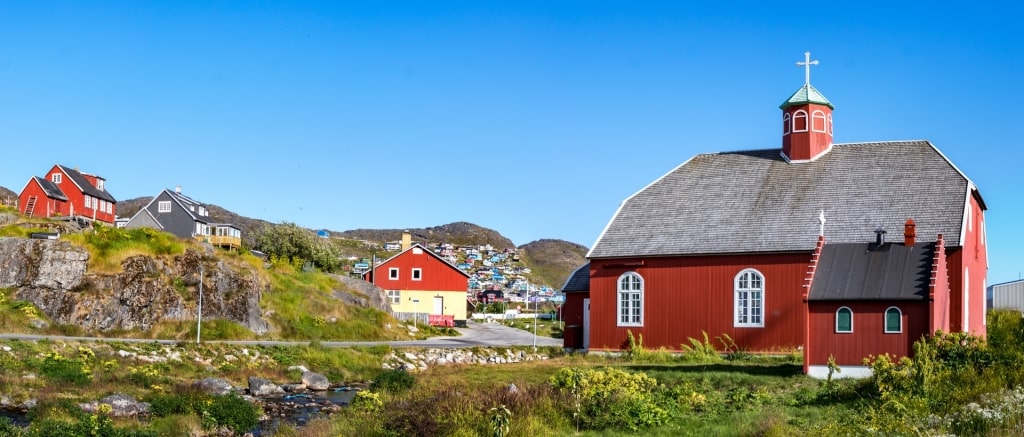
Annaasisitta Oqaluffia
Founded in 1775 by Norwegian trader and explorer Anders Olsen, Qaqortoq holds an intriguing and storied past. Settled since prehistoric times, the village was first inhabited by the Saqqaq people, more than 4,000 years ago, and then the Dorset people from Nunavut, Canada, almost 3,000 years ago. The Norse and Thule people followed, before Olsen colonized the town, deeming it “Julianehåb”.
Immerse yourself in the rich Norse and Inuit history of the village and surrounding area, with visits to ancient ruins, including a celebrated UNESCO World Heritage Site. Venture to the old church, Annaasisitta Oqaluffia, located in the center of town and dating back to the early 1800s. Here, you can take photos of this classic harborside red-and-white church and learn about the history of Christianity in Greenland.
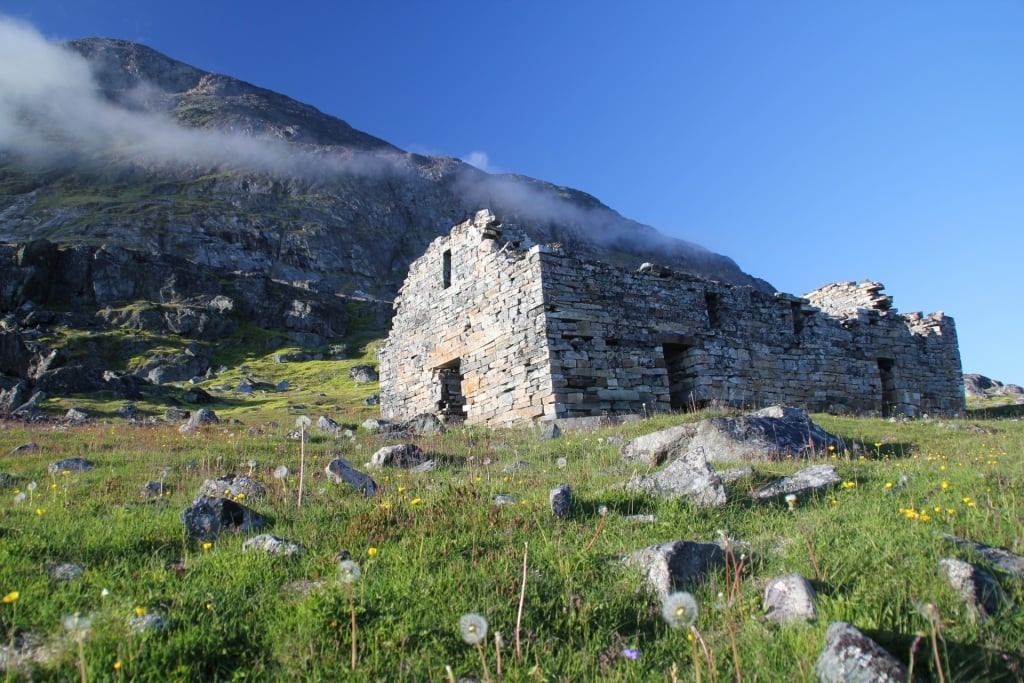
Hvalsey Church Ruins
There’s more history to be uncovered. Hop aboard a boat from the harbor and take the one-hour scenic ride over the famous Hvalsey Church Ruins, named a UNESCO World Heritage Site in 2017. The ruins date back to the 12th century and are the best-preserved near Qaqortoq.
They are just one of five areas with three main sites (Hvalsey, Igaliku, and Qassiarsuk) designated within the Kujataa historical sites, an example of agricultural practices in the subarctic climate during that time. The main church and horse stables made of stone sit as a reminder of this gathering place known as the “Eastern Settlement ” for the Norse people.
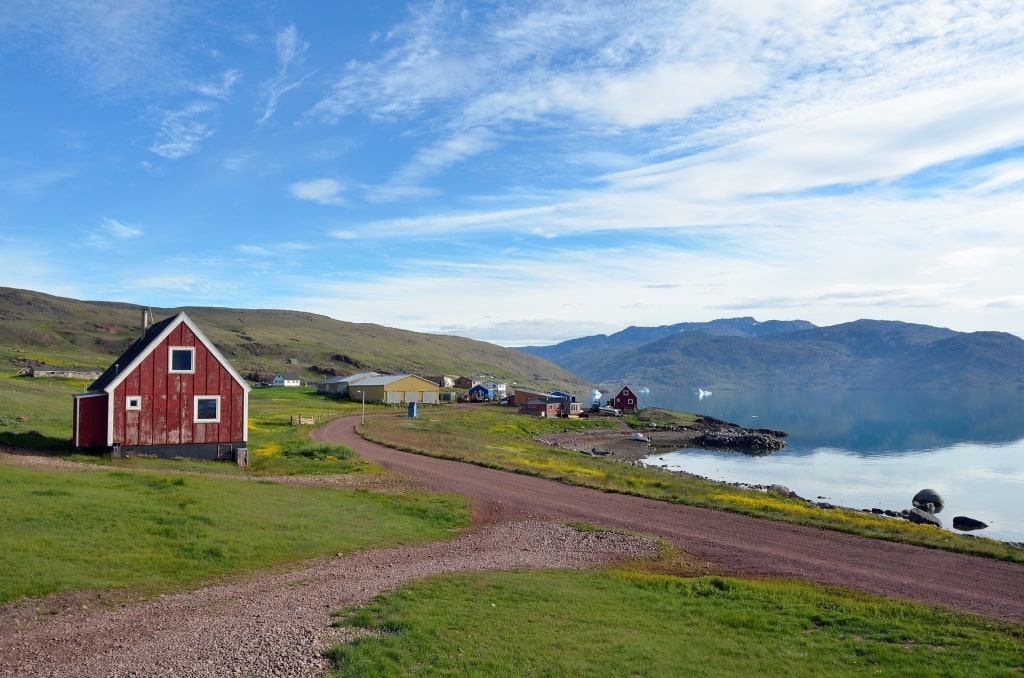
Qassiarsuk
Head to Qassiarsuk to explore another famous historic site. Travel by helicopter or boat to set foot on the same land that Viking explorers Erik the Red and his son, Leif Eriksson, both walked in ancient times.
A reconstructed Viking longhouse and Tjodhilde’s Church, the first Christian church built in North America, rest in the Tunulliarfik Fjord. Wander through Erik the Red’s residence in the Viking colony; the Brattahlid ruins date all the way back to the 10th century.
Modern Qaqortoq is the fourth-largest town in Greenland and a very social village with a friendly and hardworking culture and an Evangelical Lutheran faith. Historically a center for saddle-back seal trade, this seaport village is also known for fishing and shrimping, tanning, ship maintenance, and educational services.
Tips for Visiting Qaqortoq
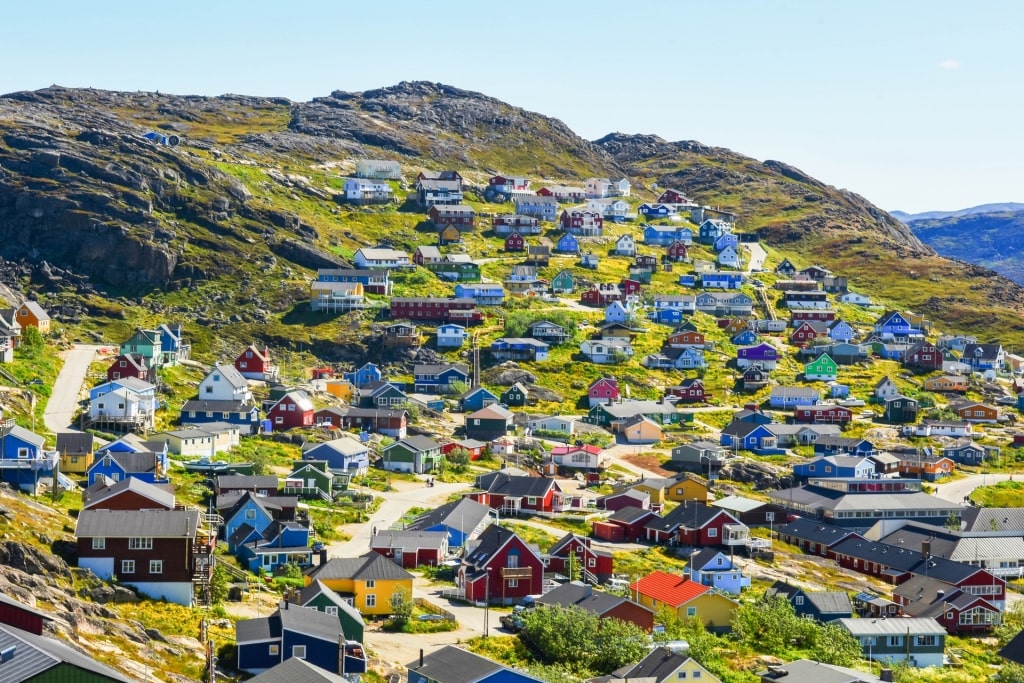
Qaqortoq
In a small village such as Qaqortoq, it’s easy to fit a lot into one day, if you’re sticking close to town. The heart of the village is very walkable, providing an ideal opportunity to stroll through the colonial-era buildings, take a photo tour, visit museums and restaurants, and observe the views with just a short walk up the surrounding hills.
If you’re venturing out of town, it’s wise to allow for a half-day or full day depending on tours that you choose to explore nearby Norse ruins, hot springs, or hiking trails.
Wildlife and Nature
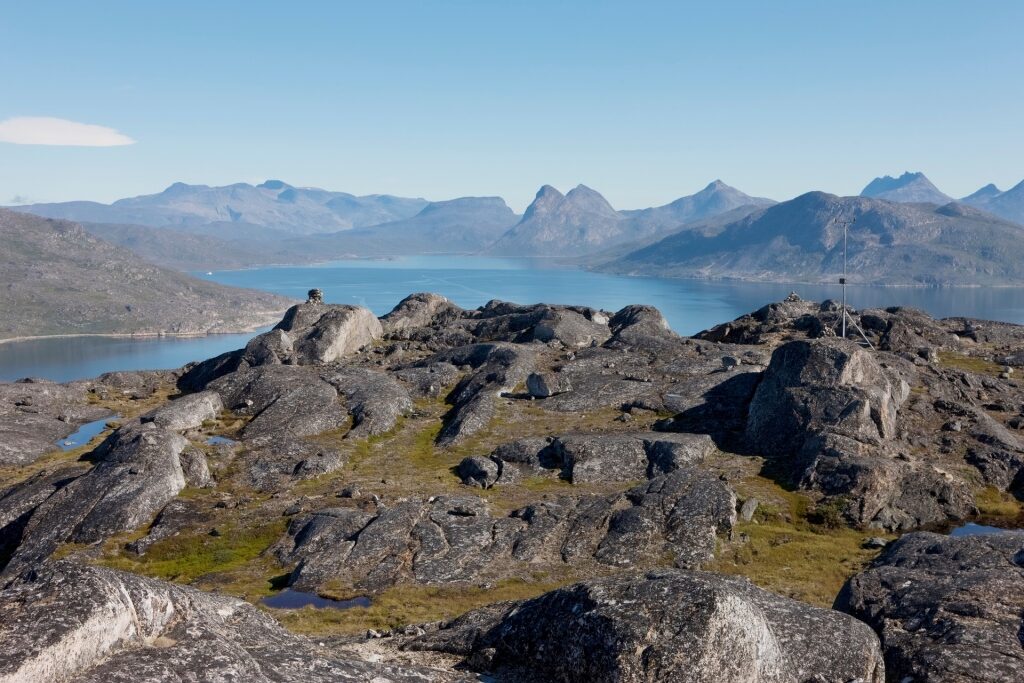
Lake Tasersuaq
You can expect wild, untouched nature surrounding Qaqortoq. This Arctic tundra has an extensive fjord system, with breathtaking coves and wildlife such as seals, and fin and humpback whales.
On land, you might spot reindeer, Arctic foxes, or snow hares while hiking. The display of wildflowers in the summer months is one of pure beauty, especially against a backdrop of distant glaciers and giant icebergs.
Hiking enthusiasts will find myriad trails leading to scenic viewpoints of the fjords, glacial lakes, and farmland. Venture to one of the most accessible trails from the center of town, where a six-mile loop trail showcases the best of the Arctic tundra.
Take in views of the vibrant colonial buildings in town, wildflowers, the Pinju Mountains, waterfalls, and the star attraction, Lake Tasersuaq, one of the best lakes in Europe. Besides being a well-loved hiking destination, the lake also happens to provide most of the water for the town of Qaqortoq. You might even spot some fresh blueberries, ripe for picking along the way.
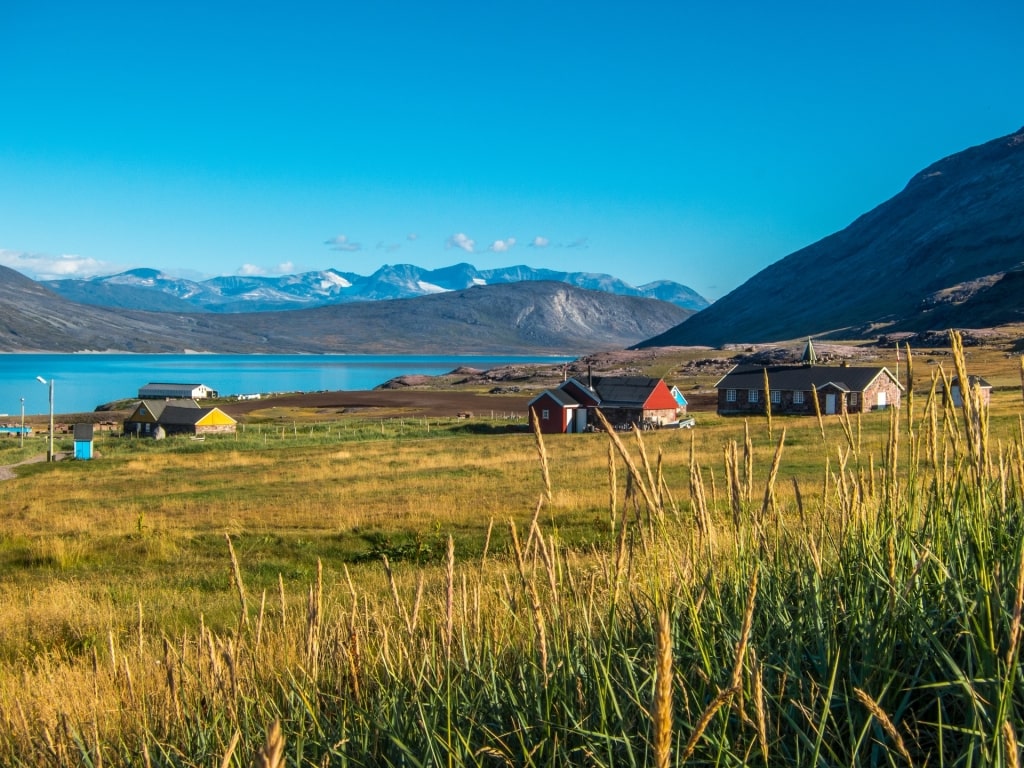
Igaliku
For another popular walking path, hop aboard a water taxi from Qaqortoq bound for Igaliku, a small sheep farming community dating back to the 1700s. The quaint village still has ruins from the Norse era and an exhibition detailing its history can be visited in the church.
The whole area is a treasure trove of hiking trails of all different lengths such as the Lake and Plateau trail and Blue Ice Camp trail, located at the mouth of the Qooroq Ice Fjord.
Kayaking is another traditional way to explore the stunning fjords surrounding Qaqortoq. Paddle through the extensive fjord network on a guided or self-guided tour; incredible views and wildlife such as seals, whales, and birds await around every corner.
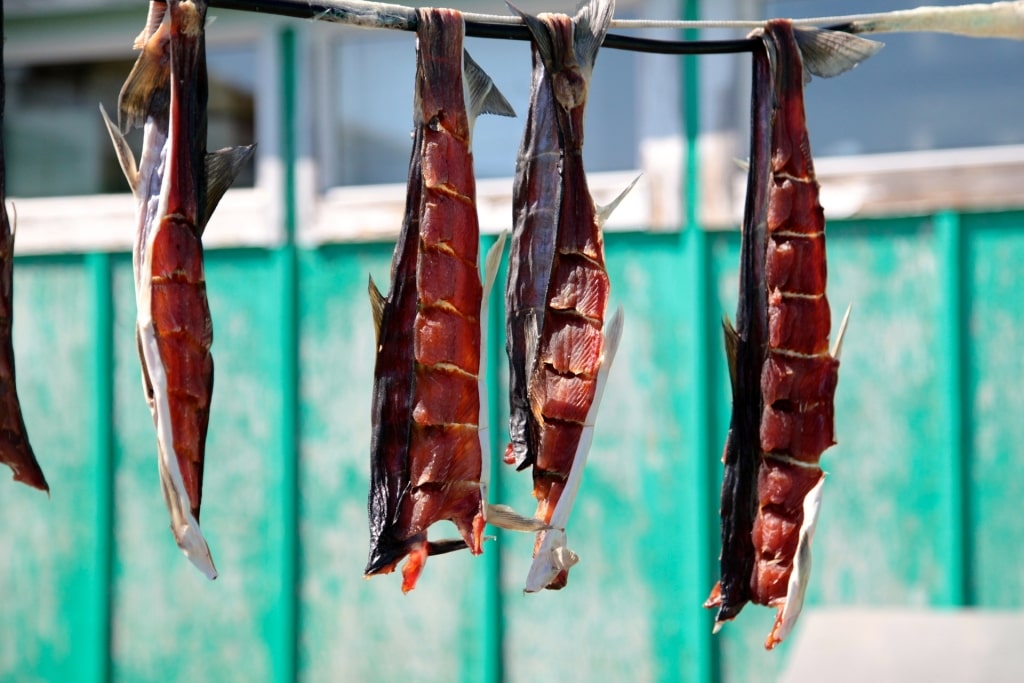
Salmon
For a pure Greenlandic experience and connection to the rich waters of the southern region, try your hand at fishing for Arctic char, salmon, trout, and cod. Known for fly fishing in the summer months, the Ilua River and Narsaq are prime destinations for casting a line in the pristine water.
If you don’t get a chance to go fishing, you can still experience the catch of the day by purchasing from local fishermen in Qaqortoq’s town center each day.
Things To Do & Attractions in Qaqortoq
Relax in a Hot Spring
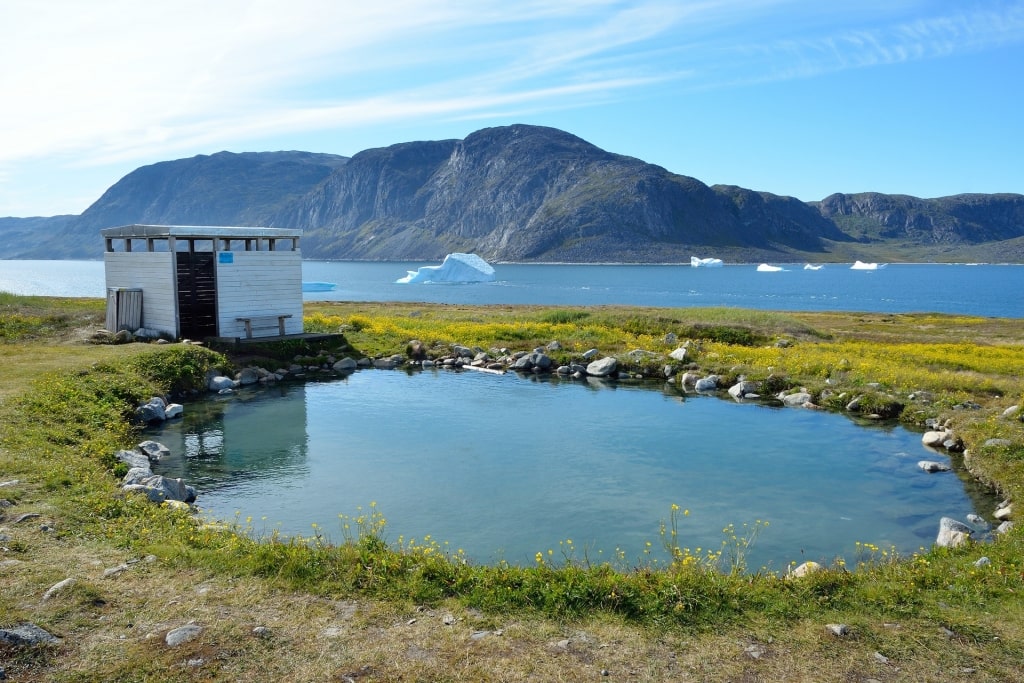
Uunartoq
One of the best things to do in Greenland is to soak in the soothing and relaxing waters of the nearby natural hot spring pools.
A two-and-a-half-hour boat ride or short flight from town to the uninhabited island of Uunartoq (meaning “warm place”) will land you in this Greenlandic outdoor spa paradise. The island was discovered by Norse Vikings and legend has it that they chose not to settle there as it was thought that the warm land was haunted.
Laze in the stone pools, heated from geothermal friction in the earth’s layers. The inviting water is usually at a comfortable 100 degrees Fahrenheit, perfect for a leisurely soak. If you’re lucky, you might spot whales in the distance as you unwind in one of the best hot springs in the world amid striking mountains, icebergs, and fjords.
Walk Around Town
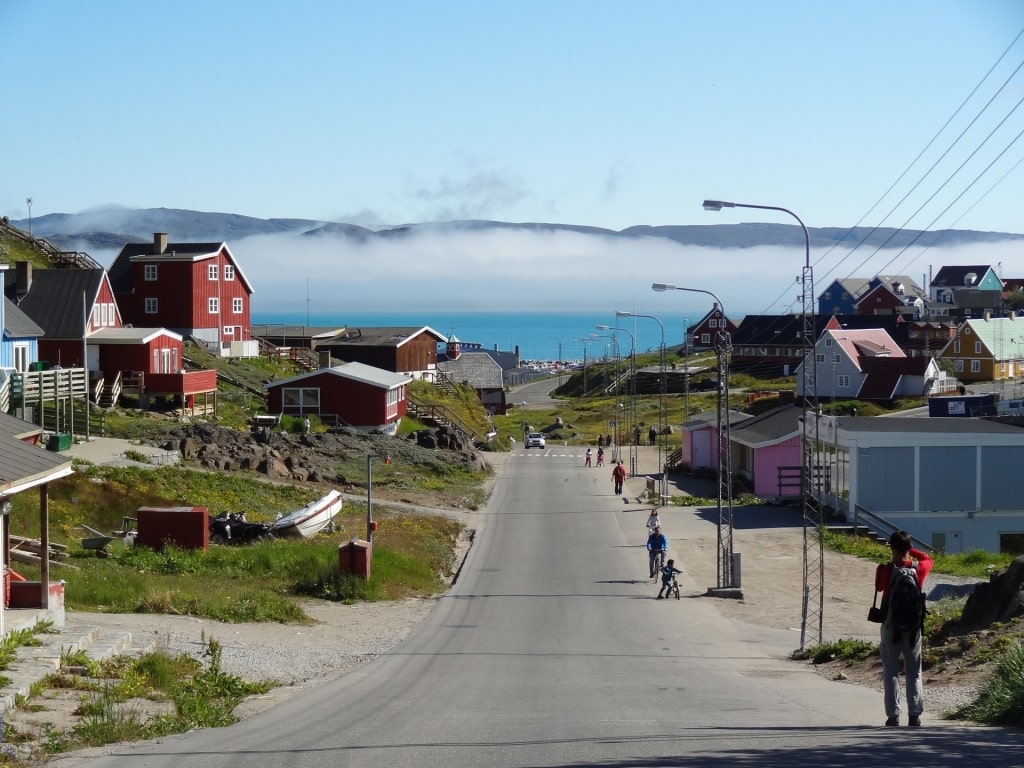
Qaqortoq
The hills immediately surrounding Qaqortoq provide beautiful overlooks of the town and fjords from above, without too much effort. This is a great option for those who are interested in taking photos and stretching their legs without committing to a longer hike.
Walk along “Vatican Hill,” named after a local resident nicknamed “the Pope.” You’ll find the “bench of love” and the famous half-car sticking out of a building, both of which make for some great photographs.
While wandering the colorful port village, make sure to browse local shops for souvenirs. One of the most popular and authentic stores is the Great Greenland Furhouse.
This local tannery and manufacturer sells clothing items, crafted from reindeer, musk ox, and seal hides. Even if you aren’t in the market for one of these unique souvenirs, it’s worth perusing to get an idea of some traditional Greenlandic dress.
Admire Art
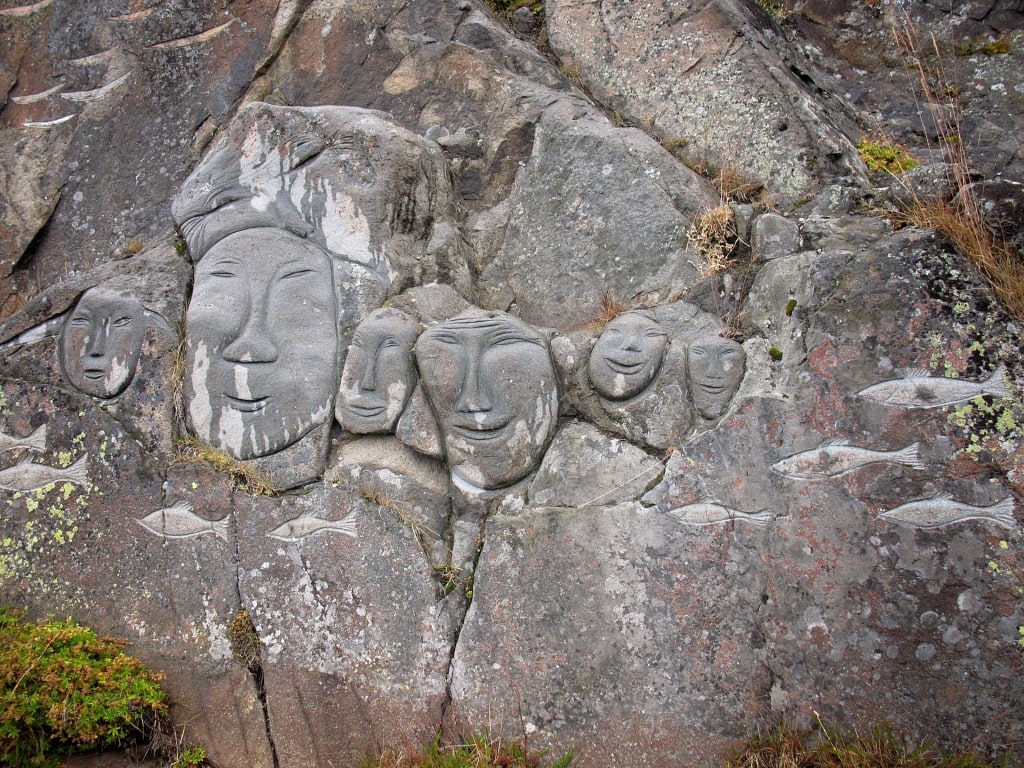
Stone & Man
No visit to Qaqortoq is complete without admiring the unique art display in town. The initiative was organized by one of the most well-known Greenlandic artists, Aka Høegh, who was born in Qaqortoq. She gathered other Nordic artists to create almost 40 works of art throughout the village, which is essentially an open-air art museum.
The project is named “Stone & Man”, and each sculpture piece is crafted using stone. This permanent exhibition of stone sculptures and carvings is one of the most celebrated and unique features of Qaqortoq.
Embark on a scavenger hunt of sorts to seek out each piece of art, which are, quite literally, carved into town.
Deep Dive into Greenlandic Culture
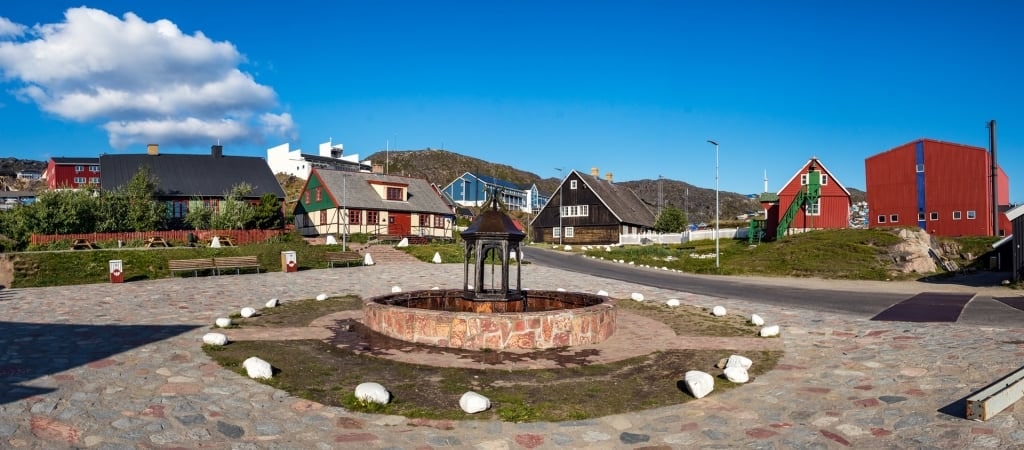
Fountain
If you visit only one museum, it should be the Qaqortoq Museum, right in the heart of town. Housed in the old blacksmith’s shop, the yellow stone building, constructed in the early 1800s, sits in the main square, next to the famous 100-year-old fountain. It also happens to be the oldest building in Qaqortoq.
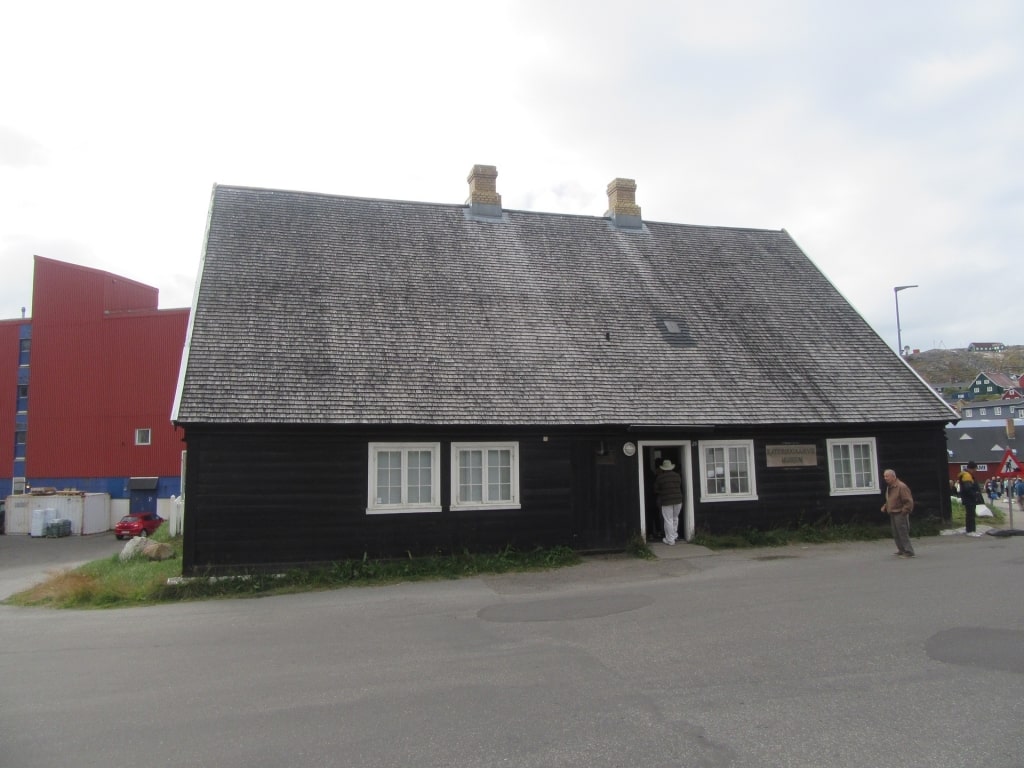
Qaqortoq Museum Photo by amanderson2 on Flickr, licensed under CC BY 2.0
Step back in time to learn about Qaqortoq’s rich history and culture through a series of exhibitions showcasing art, clothing, and other Nordic artifacts from the Norse, Thule, and Dorese cultures. Marvel at the traditional tupilaks, carved figurines said to have protective powers against enemies and evil spirits.
Tour the “Red Room” and “Blue Room,” where polar explorer Knud Rasmussen and American aviator Charles Lindbergh stayed. If you venture outside, you can also wander into the ancient turf hut, for a glimpse into lodging in Greenland’s early days. Take note of the women’s boat outside as well, typically used to transport family and belongings while the men’s kayaks were for hunting and fishing.
Food & Drink
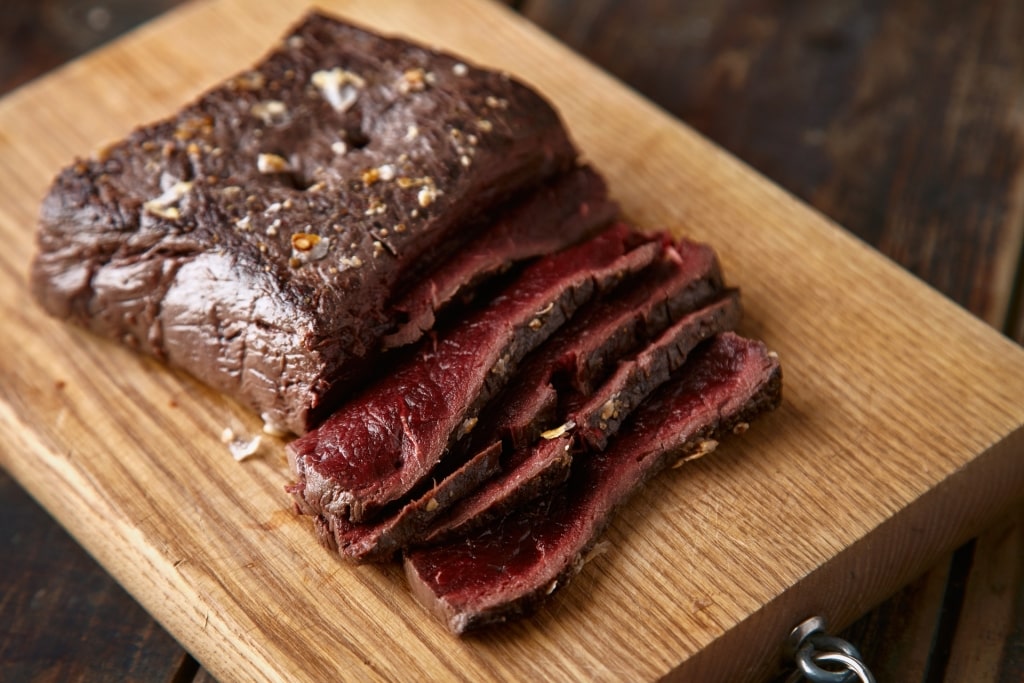
Whale meat
While exploring Qaqortoq, experiencing the local food scene will provide an excellent portal into Greenlandic culture as well. Greenlanders rely heavily on the sea and are known to use all parts of their catch.
Whales, seals, and fish all provide nourishment well past the first meal, with meat and blubber dried and preserved for the winter months, and other parts like bones, innards, and oil used in other aspects of life. For instance, bones help to create tools, and skins are used for clothing items and tents.
Adventurous eaters will find themselves in their element when tasting the flavors of Greenland. Whale meat is considered a delicacy here. Most often it’s prepared as steaks, or “Mattak”, which is whale skin with blubber, and referred to as “Greenlandic chewing gum.” Sample Suaasat, a thick broth with seal meat, barley, and onions; it’s the national dish.
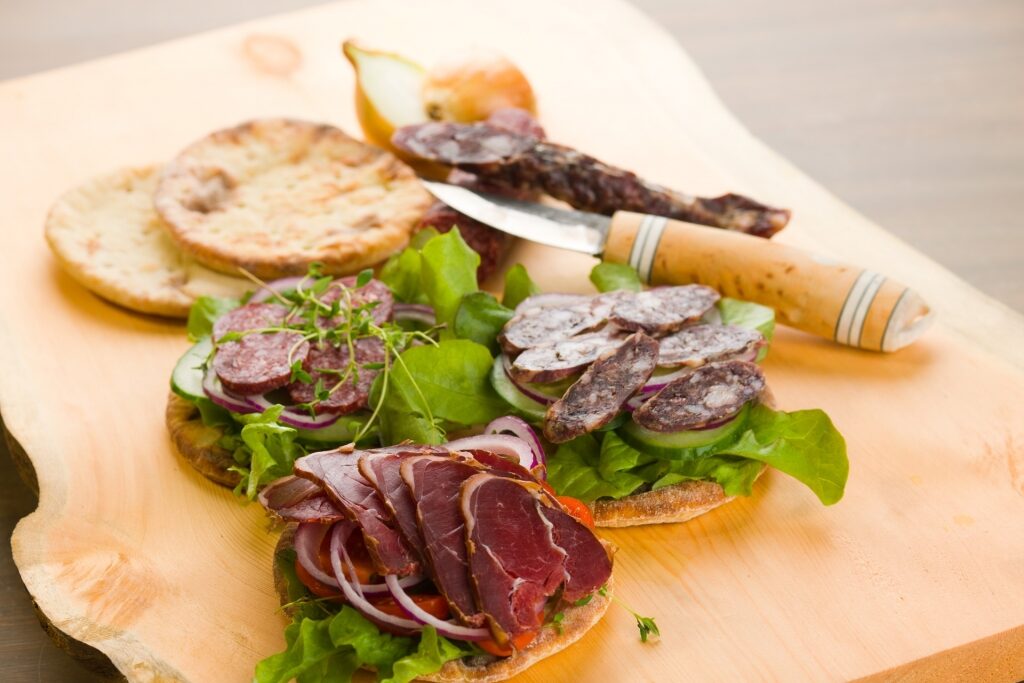
Reindeer meat
Reindeer is another popular culinary item and very versatile in the kitchen. The meat can be cooked as steak, stew, soup, sausage, and much more.
Other traditional, main fare in Greenland includes musk ox, trout, and lamb. For a cozy café experience, consider stopping in Cafe Heidi-mut or Cafe Nanoq. If you need a break from Greenlandic cuisine, there’s an excellent Thai restaurant right in town called Inbox Cafe – A Little Thai Corner.
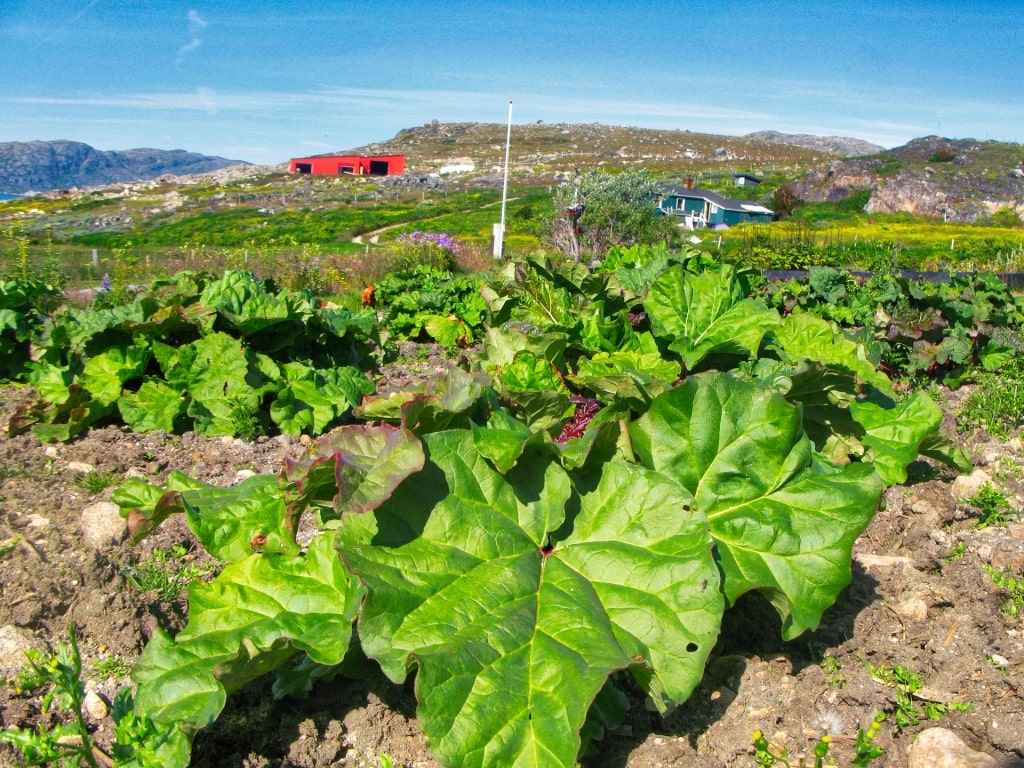
Upernaviarsuk
In addition to sampling traditional Greenlandic cuisine, the fish and meat market in town offers the chance to purchase some local foods as souvenirs.
To hear more about farming in sub-arctic conditions, stop by Upernaviarsuk, an agricultural hub and research station just outside of town. Here, you can see their gardens filled with potatoes, tomatoes, lettuce, and more, and learn about the strong farming ties since the ancient days in Qaqortoq.
Best Time to Visit Qaqortoq
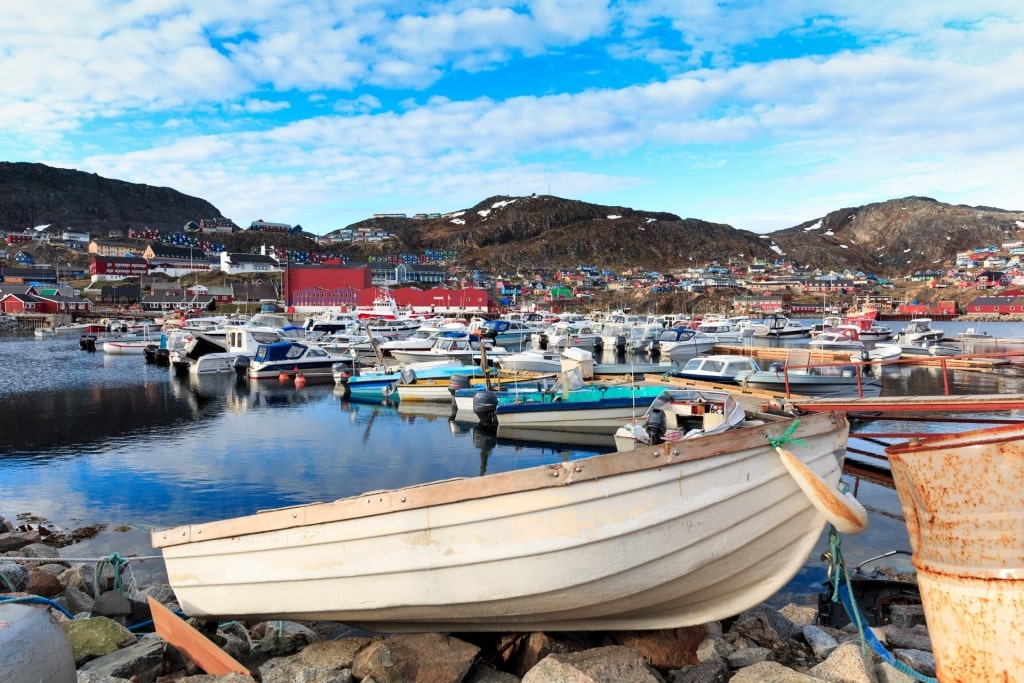
Qaqortoq
Summer is undoubtedly the best time to visit, when local hot springs and hiking trails riddled with wildflowers are easily accessible, the tundra defrosted enough to explore in depth. It’s also the optimal time to view whales in the picturesque fjords.
The summer months also allow for the most time for outdoor exploration under the midnight sun. With the sun barely setting at all, daylight provides extra hours to enjoy Qaqortoq’s natural playground. It’s best to pack in layers, as the weather can notoriously change on a dime and the temperature varies with the highs usually only reaching the mid-50s.
You’ll find yourself peeling off layers during the midday hours, when it is usually the warmest, but bundling back up for the morning and evening. Bring items that are both warm, breathable, and waterproof, as well as windproof if possible, as rain is likely at some point during your trip. Hiking or good walking shoes are ideal as well.
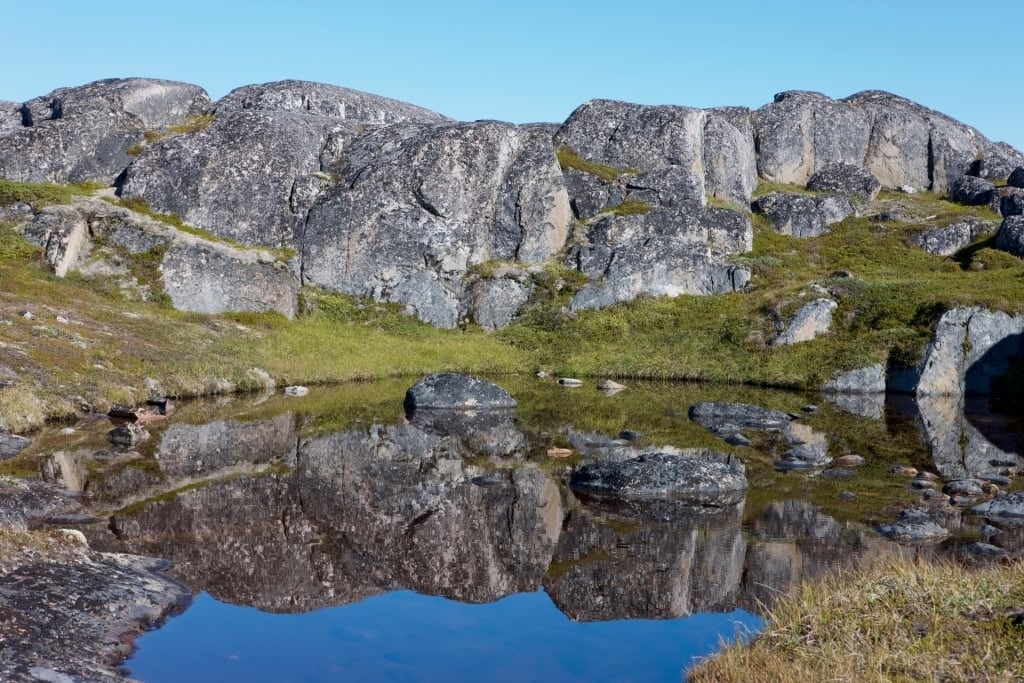
Qaqortoq
Discover all of the amazing things that Greenland has to offer on a cruise to Qaqortoq. From soaking in natural hot springs and stretching your legs on scenic hiking trails to tasting local delicacies and learning about Norse Viking history while wandering iconic ruins, Qaqortoq is an exhilarating destination.
Browse itineraries and book your Arctic adventure in Greenland today. The unspoiled outdoors awaits.
